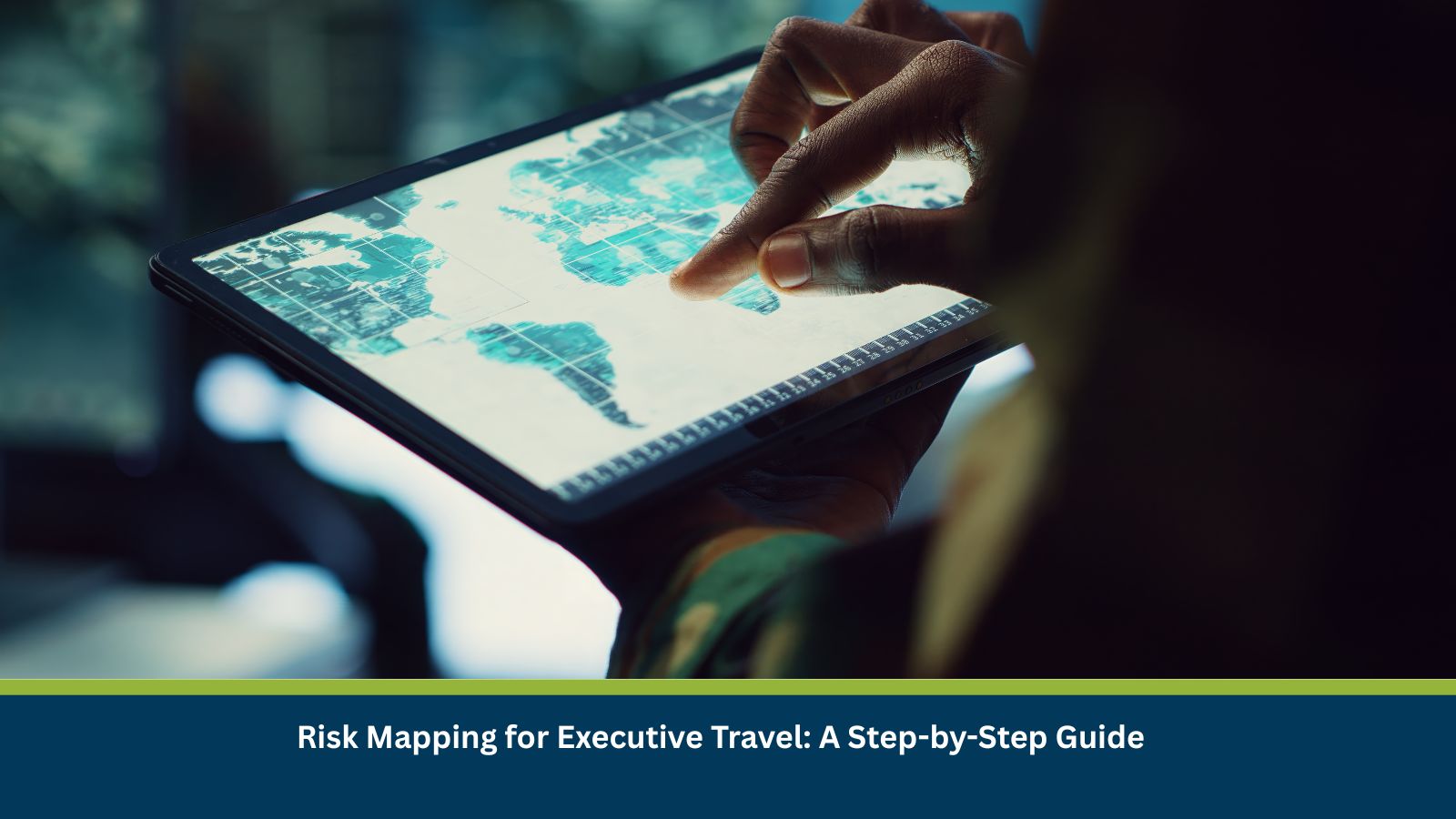In today’s unpredictable business environment, executive travel is about far more than booking flights and hotel rooms. Senior leaders are often required to travel globally – sometimes to high-risk regions, making their safety a corporate priority. Managing the risks involved in executive mobility demands a combination of risk mapping, executive protection, and travel risk management.
Together, these three elements help organizations identify potential threats, build resilience, and ensure that every business trip runs smoothly and securely. This guide walks through a step-by-step process for creating an effective risk map that safeguards executives while supporting seamless global travel.
What is Risk Mapping in Executive Travel?
Risk mapping is a strategic process that involves identifying, assessing, and visualizing potential risks that may affect travelers and their operations. When applied to executive travel, it provides a structured way to anticipate and mitigate issues, ranging from health emergencies and cyber threats to geopolitical instability.
Integrating executive protection and travel risk management into the risk mapping process helps organizations create a unified framework for safety. This approach allows businesses to pinpoint vulnerabilities early, allocate resources effectively, and respond proactively to emerging threats.
Ultimately, risk mapping transforms executive travel from a reactive process into a proactive strategy, protecting both people and performance.
Step 1: Identify Destinations and Itinerary Risks
Every destination carries its own set of risks. The first step is to analyze each location on the itinerary and assess potential threats, such as local crime rates, infrastructure reliability, political tensions, and health conditions.
For example, executives traveling to regions with unstable governments may require executive protection support, secure vehicles, and detailed contingency plans. Meanwhile, travel to highly developed but cyber-vulnerable areas may call for enhanced data encryption and secure communication protocols.
By mapping these destination-specific risks, organizations can develop a strong foundation for travel risk management that is both location-aware and responsive.
To know more about the travel risks which executives and high net worth individuals usually face while travelling abroad, click here.
Step 2: Assess the Probability and Impact of Each Risk
Once potential risks are identified, the next step is to evaluate how likely each is to occur and what its potential impact could be. Not all risks are equal—some are frequent but minor, while others are rare but catastrophic.
A risk assessment matrix helps visualize and prioritize threats based on two key factors:
- Likelihood: The probability of the risk occurring.
- Impact: The severity of its potential consequences.
High-impact threats, such as terrorism or political unrest, warrant robust executive protection and emergency planning, while lower-impact risks—like flight delays—can be managed through standard operating procedures.
This systematic assessment ensures that executive travel plans are comprehensive, focused, and proportionate to actual threat levels.
Step 3: Develop Mitigation and Contingency Strategies
Once risks are assessed, mitigation strategies must be put in place to reduce vulnerability and improve preparedness. Effective travel risk management involves both preventive and reactive measures.
Proactive mitigation could include:
- Conducting detailed pre-travel briefings and safety training.
- Vetting and securing ground transportation and accommodations.
- Engaging executive protection professionals for high-risk regions.
- Implementing strict cybersecurity protocols for mobile and digital devices.
- Establishing medical and evacuation plans in case of emergencies.
These steps provide executives with the confidence and tools they need to travel safely while ensuring the organization remains operationally resilient.
Step 4: Implement Real-Time Monitoring and Response Mechanisms
Risk conditions can change rapidly. Continuous monitoring is essential to maintaining control and ensuring quick responses during executive travel.
Real-time intelligence, GPS tracking, and automated communication systems allow organizations to track traveler safety and respond immediately to emerging threats. For example, if an executive’s destination suddenly experiences civil unrest or severe weather, the travel risk management team can instantly alert the traveler, reroute them, or activate a pre-defined emergency protocol.
By combining technology with executive protection expertise, businesses can transform risk mapping into a living, adaptable system that ensures safety throughout the journey.
Step 5: Review, Learn, and Improve Continuously
After every trip, organizations should conduct a thorough review of what worked well and where gaps existed. This feedback loop allows the travel risk management team to refine policies, update destination risk data, and strengthen emergency response capabilities.
For instance, if a communication delay occurred during an incident, adjustments can be made to ensure faster coordination in the future. Over time, this process leads to continuous improvement and stronger resilience across all aspects of executive travel.
Integrating Executive Protection into Corporate Travel Policy
For maximum effectiveness, executive protection must be integrated directly into an organization’s broader travel program, not treated as a standalone service. This means aligning it with travel booking systems, insurance coverage, and emergency communication channels.
When executive protection is fully embedded within travel risk management, organizations can ensure that every journey, whether routine or high-risk, meets the same consistent safety standards. This integration strengthens both security and confidence for traveling executives and their support teams.
Final Thoughts
In today’s fast-moving global landscape, risk mapping for executive travel is no longer optional, it’s essential. When combined with professional executive protection and comprehensive travel risk management, it creates a robust safety framework that protects people, maintains business continuity, and preserves corporate reputation.
Organizations that adopt this proactive approach don’t just manage risk, they lead with resilience. They empower their executives to travel anywhere in the world with confidence, knowing that safety is never left to chance.
Your Security Partner
MitKat’s Datasurfr platform delivers real-time, AI-powered risk intelligence, filtered and contextualised by expert analysts to support proactive decision-making. Paired with our Protective Services, we turn intelligence into action—safeguarding your leadership wherever they operate. Collaborate with MitKat to build true business resilience. From Risk Consulting and Security Design to Cyber Security and Protective Services, our integrated solutions help organisations navigate today’s complex threat landscape and build robust, future-ready risk management frameworks.






